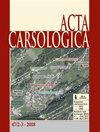Rising water flow as a factor of organic material importation into caves
IF 1.1
4区 地球科学
Q4 GEOSCIENCES, MULTIDISCIPLINARY
引用次数: 1
Abstract
The Carlucio Cave is located on the left bank of the Peruacu River canyon, in a National Park located in the semiarid zone of Minas Gerais, Southeastern Brazil. Although the Carlucio Cave is in an unfavorable relief position in terms of material importation into its interior, it harbors an important fossil deposit. This paper sought to investigate such fossil assemblage and describe material importation and deposition events. For that purpose, a survey of the existing fossils was conducted, including a description of the deposition sites and taphonomic signatures. A topographic survey was carried out of representative samples and the deposit chronology was established by means of carbon-14 and uranium-series dating. The fossil assemblage comprises mainly terrestrial epigeal mollusk shells, totaling 1,399 individuals, 70% of which are Drymaeus sp. (Bulimuloidea, Bulimulidae). In addition, 20 bones, 57 vegetal deposition sites, four charcoals, one palm fruit and one corncob were recorded. The cave location and morphology and the deposit’s taphonomic signature indicate that the material was carried upward by the rise in water level (WL) of the Peruacu River due to episodic barriers to the natural river flow, followed by floating and retention of the material once the WL went gradually down. At least four flood events that reached the Carlucio Cave were identified in the Peruacu River canyon during the Holocene. This study provides evidence of a mechanism of material transport and accumulation in the cave caused by the rising water flow in connection with flood events in the river canyon. Key words: Cave deposits, Holocene chronology, fluvial geomorphology, Peruacu River canyon. Narascanje nivoja vode kot faktor vnosa organskega materiala v jame Jama Carlucio je na levem bregu kanjona reke Peruacu v nacionalnem parku na polpuscavskem obmocju province Minas Gerais v jugovzhodni Braziliji. Ceprav je jama v neugodnem reliefnem položaju glede vnosa materiala, v njej ležijo pomembne fosilne najdbe. Ta clanek je poskusal raziskati fosile in opisati dogodke vnosa in odlaganja materiala. Zato smo pregledali obstojece fosile ter med drugim opisali odlagalisca in tafonomske podpise. Izvedli smo topografsko raziskavo reprezentativnih vzorcev ter z dolocanjem starosti z ogljikom C14 in uranovo serijo vzpostavili depozitno kronologijo. Fosilni ostanki obsegajo predvsem kopenske epigealne mehkužce s 1399 posamezniki, od tega 70 % Drymaeus sp. (Bulimuloidea, Bulimulidae). Poleg tega smo opazili 20 kosti, 57 rastlinskih talisc, stiri oglja, eno palmovo sadje in eno koruzo. Lokacija jame, njena morfologija in tafonomske raziskave sedimentov nakazujejo, da je material odneslo navzgor s porastom nivoja vode reke Peruacu zaradi epizodnih ovir pri naravnem toku reke. Temu sledi lebdenje in zadrževanje snovi, ko je nivo postopoma upadel. V holocenu smo v kanjonu reke Peruacu identificirali vsaj stiri poplavne dogodke, ki so segli v jamo Carlucio. Ta studija dokazuje mehanizem materialnega transporta in akumulacije v jami, ki jo povzroca narascajoci nivo vode v povezavi s poplavnimi dogodki v recnem kanjonu. Kljucne besede: jamski sedimenti, holocenska kronologija, recna geomorfologija, kanjon reke Perucu.上升的水流是有机物输入洞穴的一个因素
卡鲁西奥洞穴位于秘鲁河峡谷左岸,位于巴西东南部米纳斯吉拉斯半干旱区的国家公园内。尽管卡鲁西奥洞穴在物质输入内部方面处于不利的地貌位置,但它蕴藏着重要的化石矿床。本文旨在研究这种化石组合,并描述物质输入和沉积事件。为此,对现有化石进行了调查,包括对沉积地点和埋藏特征的描述。对具有代表性的样品进行了地形测量,并通过碳-14和铀系测年确定了矿床年代。化石组合主要由陆生表观软体动物外壳组成,共1399个个体,其中70%为Drymaeus sp.(Bulimuloidea,Bulimulidae)。此外,还记录了20块骨头、57个蔬菜沉积点、4个木炭、1个棕榈果和1个玉米芯。洞穴的位置和形态以及矿床的埋藏特征表明,由于天然河流流动的间歇性障碍,Peruacu河水位(WL)上升,物质被向上携带,随后WL逐渐下降,物质漂浮并滞留。全新世期间,在佩鲁阿库河峡谷中发现了至少四起到达卡鲁西奥洞穴的洪水事件。这项研究提供了证据,证明了与河流峡谷洪水事件有关的水流上升导致洞穴中物质运输和堆积的机制。关键词:洞穴沉积,全新世纪年,河流地貌,Peruacu河峡谷。卡鲁西奥洞穴位于巴西东南部米纳斯吉拉斯省半干旱地区的一个国家公园内的佩鲁阿库河峡谷左岸。尽管洞穴在物质输入方面处于不利的起伏位置,但它包含了重要的化石发现。这个clanek试图探索化石,并描述物质输入和沉积的事件。因此,我们检查了化石的存在,并描述了沉积物和taphonome特征等。对代表性样品进行了地形调查,并通过确定C14碳系和铀系的年龄来确定矿床年代。化石残骸主要由陆地表观软体动物组成,共有1399个个体,其中70%为Drymaeus sp.(Bulimuloidea,Bulimulidae)。此外,我们还观察到20块骨头、57块植物化石、4块木炭、1块棕榈果和1块玉米。洞穴的位置、形态和沉积物的埋藏学研究表明,由于Peruacu河自然流动中的偶发性障碍,随着水位的升高,物质被向上携带。随后,随着水位逐渐下降,出现了漂浮物和滞留物。在全新世,我们在佩鲁阿库河峡谷中发现了至少四次洪水事件,这些事件到达了卡鲁西奥洞穴。这个工作室展示了倾斜峡谷洪水事件中水位上升引起的洞穴中物质运输和积累的机制。关键词:洞穴沉积物,全新世纪年,recna地貌,Perucu河峡谷。
本文章由计算机程序翻译,如有差异,请以英文原文为准。
求助全文
约1分钟内获得全文
求助全文
来源期刊

Acta Carsologica
地学-地球科学综合
CiteScore
1.50
自引率
14.30%
发文量
0
审稿时长
>12 weeks
期刊介绍:
Karst areas occupy 10-20 % of ice-free land. Dissolution of rock by natural waters has given rise to specific landscape and underground. Karst surface features and caves have attracted man''s curiosity since the dawn of humanity and have been a focus to scientific studies since more than half of millennia.
Acta Carsologica publishes original research papers and reviews, letters, essays and reports covering topics related to specific of karst areas. These comprise, but are not limited to karst geology, hydrology, and geomorphology, speleology, hydrogeology, biospeleology and history of karst science.
 求助内容:
求助内容: 应助结果提醒方式:
应助结果提醒方式:


